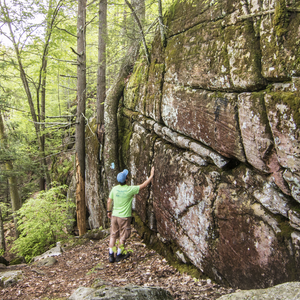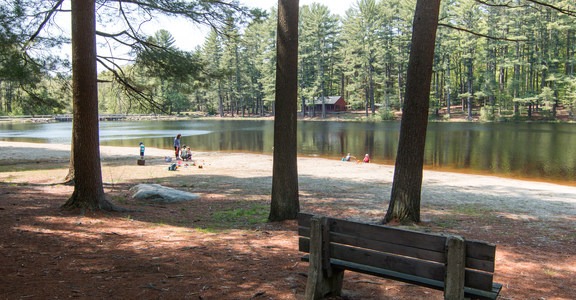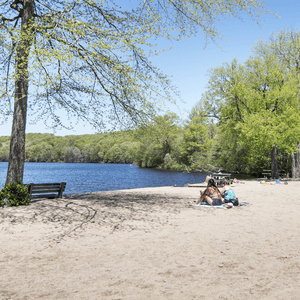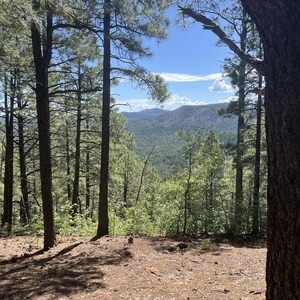You are here
Chatfield Hollow State Park in Killingworth, Connecticut, is a family-fun place to hike, swim, explore, and learn. There are 23 miles of trails and roads past metamorphic outcroppings, planted pine groves, bountiful fishing ponds, long sandy beaches, Indian caves, and a historic nature center.
The park is open from the second Saturday in April to the day after Columbus Day in October. During this time you can visit from 8:00 a.m. to sunset. There is a weekend/holiday fee of $9 for residents and $15 for non-residents. On these days, the gate near the entrance booth is open for access to an upper parking lot. There are also some handicap parking spots next to the beach area. Regular visitors can also purchase a season pass for unlimited vehicle access to Connecticut State Parks (with a few exceptions), which is valid for one vehicle and is non-transferable. Residents should also check out the library’s museum pass program for additional discounts.
From the parking area near the entrance, the closest trail is the G-Green Chimney Trail, which hosts a rock scramble and Indian Caves. Farther up, the W-White Lookout Trail is an approximately 1.25-mile loop through the forest. From here, you can connect to the B-Blue East Woods Trail, which passes stone walls, the Schubert Marsh, and a few outcroppings. The G-Green Chimney Trail has a second loop near the Lookout Trail and is a bit difficult to follow due to faded markers. It follows a mile-long circuit with some minor scrambling and a few stream crossings. The P-Purple Covered Bridge Trail is a relatively flat path along the stream, and the Paul Wilderman Boardwalk connects two paved roads that enter and exit the park. The Connecticut Department of Energy and Environmental Protection maintains a MAP of these trails with the location of the park's many features.
Chatfield Hollow became a state park in 1949, but the history of its development began over a decade earlier, in 1933, with President Franklin Delano Roosevelt and Civilian Conservation Corps Company 171. At that time, the president implemented the CCC program throughout the country to help provide paid work opportunities for families following the Great Depression. The CCC put unmarried, unemployed, healthy males between 18 and 25 years of age to work in camps throughout the country developing public refuges. Chatfield Hollow was the first of these camps in Connecticut and thus was named after President Roosevelt. These young men are responsible for much of the park’s features that families get to enjoy today. They constructed the roads, planted trees, assembled the nature center (Oak Lodge), and built the dam that creates Schreeder Pond. They were paid $30 per month, $25 of which was sent directly to their parents.
Native Americans once used this area for fishing, hunting, and tribal ceremonies. Thousands of artifacts have been found in the vicinity of these natural caves and rock outcroppings, and the main road along the brook was originally an Native American trail. With the arrival of early settlers and the Chatfield brothers in 1639 came the construction of mills and stone buildings throughout the property. It is believed that there was once a gristmill for grains and an iron furnace for smelting native ores. The restored waterwheel on the upper pond is a reminder of these industry activities that shaped the new colonies.
All of the exposed light-colored bedrock is called Monson Gneiss, which is the result of geological formations that took place millions of years ago. Originally at the edge of North America, this once-igneous rock was submerged by the force of colliding continents. It melted, created magmatic chambers, and cooled to form granitic pluton. This was followed by more continental collisions, folding, and compression occurring beneath layers of sedimentary rock. Millions of years of erosion have now revealed the large metamorphic outcroppings that you see today. Rounder rocks speckle the grounds as a reminder of the glaciers that towered overhead over 14,000 years ago. More of this geology can be found in Forster Pond State Park on the Chatfield Trail located across the road.








Comments
Sign In and share them.